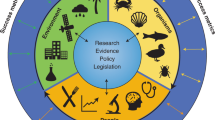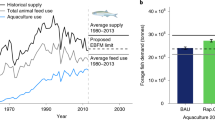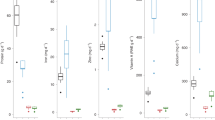Abstract
Aquaculture, the farming of fish and seafood, is recognized as a highly efficient system for producing protein for human consumption. In contrast, many terrestrial animal protein production systems are inefficient, impacting land use and exacerbating climate change. Humankind needs to adopt a more plant-centric diet, the only exception being fish consumed as both a source of protein and essential dietary nutrients such as omega-3 fatty acids. Here we consider the implications of such a transition, and the challenges that aquaculture must overcome to increase productivity within planetary boundaries. We consider how agriculture, specifically crops, can provide solutions for aquaculture, especially the sectors that are dependent on marine ingredients. For example, agriculture can provide experience with managing monocultures and new technologies such as genetically modified crops tailored specifically for use in aquaculture. We propose that a closer connection between agriculture and aquaculture will create a resilient food system capable of meeting increasing dietary and nutritional demands without exhausting planetary resources.
This is a preview of subscription content, access via your institution
Access options
Access Nature and 54 other Nature Portfolio journals
Get Nature+, our best-value online-access subscription
$29.99 / 30 days
cancel any time
Subscribe to this journal
Receive 12 digital issues and online access to articles
$119.00 per year
only $9.92 per issue
Buy this article
- Purchase on Springer Link
- Instant access to full article PDF
Prices may be subject to local taxes which are calculated during checkout

Similar content being viewed by others
References
Willett, W. et al. Food in the Anthropocene: the EAT–Lancet Commission on healthy diets from sustainable food systems. Lancet 393, 447–492 (2019).
Tubb, C. & Seba, T. Rethinking Food and Agriculture 2020–2030 (RethinkX, 2019); https://www.rethinkx.com/food-and-agriculture.
Calder, P. C. Very long-chain n-3 fatty acids and human health: fact, fiction and the future. Proc. Nutr. Soc. 77, 52–72 (2018).
Hamilton, H. A., Newton, R., Auchterlonie, N. A. & Müller, D. B. Systems approach to quantify the global omega-3 fatty acid cycle. Nat. Food 1, 59–62 (2020).
The State of World Fisheries and Aquaculture 2020: Sustainability in Action (FAO, 2020).
Troell, M., Jonell, M. & Crona, B. The Role of Seafood in Sustainable and Healthy Diets: The EAT-Lancet Commission Report Through a Blue Lens (EAT, 2020); https://go.nature.com/3dL0ntC.
The Continuing Importance of Fishmeal and Fish Oil in Aquafeeds (IFFO, 2018); https://www.iffo.com/system/files/downloads/AquaFarm%20Feb18%20NA.pdf
Gatlin, D. M. et al. Expanding the utilization of sustainable plant products in aquafeeds: a review. Aquacult. Res. 38, 551–579 (2007).
Turchini, G. M., Ng, W. K. & Tocher, D. R. (eds) Fish Oil Replacement and Alternative Lipid Sources in Aquaculture Feeds (Taylor & Francis, CRC, 2011).
Shepherd, C. J., Monroig, O. & Tocher, D. R. Future availability of raw materials for salmon feeds and supply chain implications: the case of Scottish farmed salmon. Aquaculture 467, 49–62 (2017).
Aas, T. S., Ytrestøyl, T. & Åsgård, T. Utilization of feed resources in the production of Atlantic salmon (Salmo salar) in Norway: an update for 2016. Aquacult. Rep. 15, 100216 (2019).
Tocher, D. R. Omega-3 long-chain polyunsaturated fatty acids and aquaculture in perspective. Aquaculture 449, 94–107 (2015).
Naylor, R. L. et al. Feeding aquaculture in an era of finite resources. Proc. Natl Acad. Sci. USA 106, 15103–15110 (2009).
Ytrestøyl, T., Aas, T. S. & Åsgård, T. Utilisation of feed resources in production of Atlantic salmon (Salmo salar). Aquaculture 448, 365–374 (2015).
Sprague, M., Dick, J. R. & Tocher, D. R. Impact of sustainable feeds on omega-3 long-chain fatty acid levels in farmed Atlantic salmon, 2006–2015. Sci. Rep. 6, 21892 (2016).
Sprague, M., Betancor, M. B., Dick, J. R. & Tocher, D. R. Nutritional evaluation of seafood, with respect to long-chain omega-3 fatty acids, available to UK consumers. Proc. Nutr. Soc. 76, E38 (2017). (OCE2).
Tocher, D. R. Metabolism and functions of lipids and fatty acids in teleost fish. Rev. Fish. Sci. 11, 107–184 (2003).
Tocher, D. R. Fatty acid requirements in ontogeny of marine and freshwater fish. Aquacult. Res. 41, 717–732 (2010).
Montero, D. & Izquierdo, M. in Fish Oil Replacement and Alternative Lipid Sources in Aquaculture Feeds (eds Turchini, G. M. et al.) 439–485 (Taylor & Francis, CRC, 2011).
Tocher, D. R. & Glencross, B. D. in Dietary Nutrients, Additives, and Fish Health (eds Lee, C.-S. et al.) 47–94 (Wiley-Blackwell, 2015).
Houston, R. D. et al. Harnessing genomics to fast-track genetic improvement in aquaculture. Nat. Rev. Genet. https://doi.org/10.1038/s41576-020-0227-y (2020).
Mehrabi, Z., Gill, M., Wijk, M., Herrero, M. & Ramankutty, N. Livestock policy for sustainable development. Nat. Food 1, 160–165 (2020).
Herman, E. M. & Schmidt, M. A. The potential for engineering enhanced functional-feed soybeans for sustainable aquaculture feed. Front. Plant Sci. 7, 440 (2016).
Domergue, F., Abbadi, A. & Heinz, E. Relief for fish stocks: oceanic fatty acids in transgenic oilseeds. Trends Plant Sci. 10, 112–116 (2005).
Tocher, D. R., Betancor, M. B., Sprague, M., Olsen, R. E. & Napier, J. A. Omega-3 long-chain polyunsaturated fatty acids, EPA and DHA: bridging the gap between supply and demand. Nutrients 11, 89 (2019).
Petrie, J. R. et al. Development of a Brassica napus (Canola) crop containing fish oil-like levels of DHA in the seed oil. Front. Plant Sci. 11, 727 (2020).
Betancor, M. B. et al. A nutritionally-enhanced oil from transgenic Camelina sativa effectively replaced marine fish oil as a source of eicosapentaenoic acid for farmed Atlantic salmon (Salmo salar). Sci. Rep. 5, 8104 (2015).
Han, L. et al. High level accumulation of EPA and DHA in field-grown transgenic Camelina—a multi-territory evaluation of TAG accumulation and heterogeneity. Plant Biotechnol J. https://doi.org/10.1111/pbi.13385 (2020).
Betancor, M. B. et al. Oil from transgenic Camelina sativa containing over 25 % n-3 long-chain polyunsaturated fatty acids as the major lipid source in feed for Atlantic salmon (Salmo salar). Br. J. Nutr. 119, 1378–1392 (2018).
Ruyter, B. et al. n-3 Canola oil effectively replaces fish oil as a new safe dietary source of DHA in feed for juvenile Atlantic salmon. Br. J. Nutr. 122, 1329–1345 (2019).
West, A. L. et al. Postprandial incorporation of EPA and DHA from transgenic Camelina sativa oil into blood lipids is equivalent to that from fish oil in healthy humans. Br. J. Nutr. 121, 1235–1246 (2019).
Lim, K. C., Yusoff, F. M., Shariff, M. & Kamarudin, M. S. Astaxanthin as feed supplement in aquatic animals. Rev. Aquacult. 10, 738–773 (2018).
Breitenbach, J. et al. Engineered maize as a source of astaxanthin: processing and application as fish feed. Transgenic Res. 25, 785–793 (2016).
Park, H. et al. Towards the development of a sustainable soya bean‐based feedstock for aquaculture. Plant Biotechnol. J. 15, 227–236 (2017).
Nogueira, M. et al. Engineering of tomato for the sustainable production of ketocarotenoids and its evaluation in aquaculture feed. Proc. Natl Acad. Sci. USA 114, 10876–10881 (2017).
Clarke, J. L., Waheed, M. T., Lössl, A. G., Martinussen, I. & Daniell, H. How can plant genetic engineering contribute to cost-effective fish vaccine development for promoting sustainable aquaculture? Plant Mol. Biol. 83, 33–40 (2013).
Simon, J. C. & Peccoud, J. Rapid evolution of aphid pests in agricultural environments. Curr. Opin. Insect Sci. 26, 17–24 (2018).
Barrett, L. T., Overton, K., Stien, L. H., Oppedal, F. & Dempster, T. Effect of cleaner fish on sea lice in Norwegian salmon aquaculture: a national scale data analysis. Int. J. Parisitol. 50, 787–796 (2020).
Jones, S. W., Karpol, A., Friedman, S., Maru, B. T. & Tracy, B. P. Recent advances in single cell protein use as a feed ingredient in aquaculture. Curr. Opin. Biotechnol. 61, 189–197 (2020).
Arru, B., Furesi, R., Gasco, L., Madau, F. A. & Pulina, P. The introduction of insect meal into fish diet: the first economic analysis on European sea bass farming. Sustainability 11, 1697 (2019).
Ringø, E. et al. Effect of dietary components on the gut microbiota of aquatic animals. A never-ending story? Aquacult. Nutr. 22, 219–282 (2016).
European Food Safety Authority. Scientific opinion on the efficacy of Bactocell (Pediococcus acidilactici) when used as a feed additive for fish. EFSA J. 10, 2886 (2012).
Ringø, E., Olsen, R. E., Gonzalez Vecino, J. L., Wadsworth, S. & Song, S. K. Use of immunostimulants and nucleotides in aquaculture: a review. J. Mar. Sci. Res. Dev. 2, 104 (2012).
de Freitas Souza, C. et al. Essential oils as stress-reducing agents for fish aquaculture: a review. Front. Physiol. 10, 785 (2019).
Napier, J. A., Haslam, R. P., Tsalavouta, M. & Sayanova, O. The challenges of delivering genetically modified crops with nutritional enhancement traits. Nat. Plants 5, 563–567 (2019).
Acknowledgements
Rothamsted Research receives grant-aided support from the BBSRC. J.A.N. and R.P.H. were partially supported by BBSRC ISPG Tailoring Plant Metabolism (BBS/E/C/000I0420). J.A.N., D.R.T. and M.B.B. were partly supported by BBSRC IPA, Evaluating novel plant oilseeds enriched in omega-3 long-chain polyunsaturated fatty acids to support sustainable development of aquaculture (BB/J001252/1), and BBSRC IPA Novel omega-3 sources in feeds and impacts on salmon health (BB/S005919/1). R.-E.O., J.A.N., D.R.T. and M.B.B. were also partly supported by Research Council of Norway HAVBRUK Program grant no. 245325, Transgenic oilseed crops as novel, safe, sustainable and cost-effective sources of EPA and DHA for salmon feed.
Author information
Authors and Affiliations
Corresponding author
Ethics declarations
Competing interests
J.A.N. is listed as an inventor on patents (granted and pending) relating to the production of omega-3 LC-PUFAs in transgenic plants (patent GB1206483.8 and subsequent family members).
Additional information
Peer review information Nature Food thanks Sachi Kaushik, Surinder Singh and the other, anonymous, reviewer(s) for their contribution to the peer review of this work.
Publisher’s note Springer Nature remains neutral with regard to jurisdictional claims in published maps and institutional affiliations.
Rights and permissions
About this article
Cite this article
Napier, J.A., Haslam, R.P., Olsen, RE. et al. Agriculture can help aquaculture become greener. Nat Food 1, 680–683 (2020). https://doi.org/10.1038/s43016-020-00182-9
Received:
Accepted:
Published:
Issue Date:
DOI: https://doi.org/10.1038/s43016-020-00182-9
This article is cited by
-
Cyrtocarpa edulis fruit and its immunostimulant effect on Almaco Jack Seriola rivoliana: in vitro, in vivo and ex vivo studies
Veterinary Research Communications (2024)
-
Silica-Gel Incorporated Biosynthesized-Silver Nanoparticles for Sustainable Antimicrobial Treatment of Brackish Water Aquaculture
Arabian Journal for Science and Engineering (2023)
-
Sustainability of the rice-crayfish co-culture aquaculture model: microbiome profiles based on multi-kingdom analyses
Environmental Microbiome (2022)



